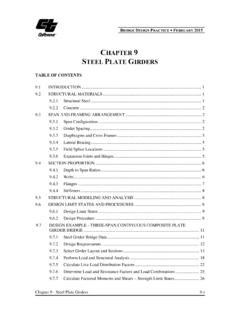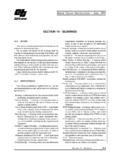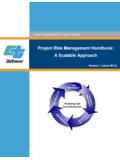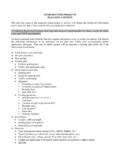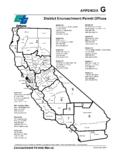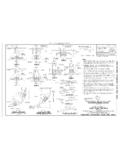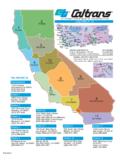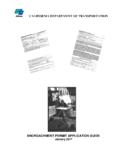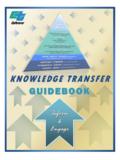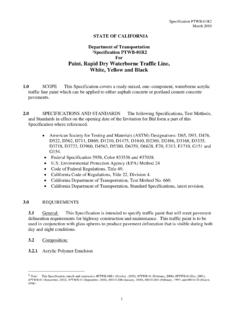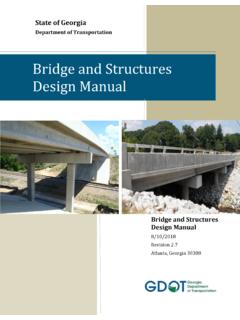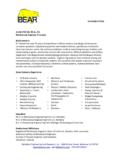Transcription of CHAPTER 3 OADS AND LOAD COMBINATIONS - …
1 bridge design PRACTICE FEBRUARY 2015. CHAPTER 3. LOADS AND load COMBINATIONS . TABLE OF CONTENTS. INTRODUCTION .. 3-1. load 3-1. load DEFINITIONS .. 3-3. Permanent Loads .. 3-3. Transient Loads .. 3-3. PERMANENT load APPLICATION WITH EXAMPLES .. 3-3. Dead load of Components, DC .. 3-5. Dead load of Wearing Surfaces and Utilities, DW .. 3-5. Downdrag, DD .. 3-6. Horizontal Earth Pressure, EH .. 3-6. Vertical Pressure from Dead load of Earth Fill, EV .. 3-7. Earth Surcharge, ES .. 3-7. Force Effect Due to Creep, CR .. 3-7. Force Effect Due to Shrinkage, SH .. 3-7. Forces from Post-Tensioning, PS .. 3-8. Miscellaneous Locked-in Force Effects Resulting from the Construction Process, EL .. 3-9. TRANSIENT load APPLICATION WITH EXAMPLES .. 3-9. Vehicular Live load , LL.
2 3-9. Vehicular Dynamic load Allowance, IM .. 3-15. Vehicular Braking Force, BR .. 3-15. Vehicular Centrifugal Force, CE .. 3-16. Live load Surcharge, LS .. 3-17. Pedestrian Live load , PL .. 3-18. Uniform Temperature, TU .. 3-18. CHAPTER 3 Loads and load COMBINATIONS 3-i bridge design PRACTICE FEBRUARY 2015. Temperature Gradient, 3-20. Settlement, SE .. 3-20. Water load and Stream Pressure, WA .. 3-20. Wind load on Structure, WS .. 3-22. Wind on Live load , WL .. 3-24. Friction, 3-25. Ice load , IC .. 3-26. Vehicular Collision Force, CT .. 3-26. Vessel Collision Force, 3-27. Earthquake, EQ .. 3-27. load DISTRIBUTION FOR BEAM-SLAB BRIDGES .. 3-27. Permanent Loads .. 3-27. Live Loads on Superstructure .. 3-28. Live Loads on Substructure .. 3-36. Skew Modification of Shear Force in Superstructures.
3 3-40. load FACTORS AND combination .. 3-43. 3-45. REFERENCES .. 3-48. CHAPTER 3 Loads and load COMBINATIONS 3-ii bridge design PRACTICE FEBRUARY 2015. CHAPTER 3. LOADS AND load COMBINATIONS . INTRODUCTION. Properly identifying bridge loading is fundamental to the design of each component. bridge design is iterative in the sense that member sizes are a function of loads and loads are a function of member sizes. It is, therefore, necessary to begin by proportioning members based on prior experience and then adjusting for actual loads and bridge geometry. This CHAPTER summarizes the loads to be applied to bridges specified in the AASHTO LRFD bridge design Specifications, 6th Edition (AASHTO, 2012) and the California Amendments to the AASHTO LRFD bridge design Specifications (CA).
4 (Caltrans, 2014). It is important to realize that not every load listed will apply to every bridge . For example, a bridge located in Southern California may not need to consider ice loads. A pedestrian overcrossing structure may not have to be designed for vehicular live load . load Path The Engineer must provide a clear load path. The following illustrates the pathway of truck loading into the various elements of a box girder bridge . Figure Truck load Path from Deck Slab to Girders The weight of the truck is distributed to each axle of the truck. One half of the axle load then goes to each wheel or wheel tandem. This load will be carried by the deck slab which spans between girders, see Figure CHAPTER 3 Loads and load COMBINATIONS 3-1. bridge design PRACTICE FEBRUARY 2015.
5 Once the load has been transferred to the girders, the direction of the load path changes from transverse to longitudinal . The girders carry the load by spanning between bents and abutments (Figure ). Figure Truck load Path from Girders to Bents 12' 12' 12' 12'. Figure Truck load on Bent Cap When the girder load reaches the bent caps or abutments, it once again changes direction from longitudinal to transverse. The bent cap beam transfers the load to the columns. load distribution in the substructure is covered in Section The columns are primarily axial load carrying members and carry the load to the footing and finally to the piles. The piles transfer the load to the soil where it is carried by the soil matrix. load distribution can be described in a more refined manner, however, the basic load path from the truck to the ground is as described above.
6 Each load in Table CA. has a unique load path. Some are concentrated loads, others are uniform line loads, while still others, such as wind load , are pressure forces on a surface. CHAPTER 3 Loads and load COMBINATIONS 3-2. bridge design PRACTICE FEBRUARY 2015. load DEFINITIONS. Permanent Loads Permanent loads are defined as loads and forces that are either constant or varying over a long time interval upon completion of construction. They include dead load of structural components and nonstructural attachments (DC), dead load of wearing surfaces and utilities (DW), downdrag forces (DD), horizontal earth pressure loads (EH), vertical pressure from dead load of earth fill (EV), earth surcharge load (ES), force effects due to creep (CR), force effects due to shrinkage (SH), secondary forces from post-tensioning (PS), and miscellaneous locked-in force effects resulting from the construction process (EL).
7 Transient Loads Transient loads are defined as loads and forces that are varying over a short time interval. A transient load is any load that will not remain on the bridge indefinitely. This includes vehicular live loads (LL) and their secondary effects including dynamic load allowance (IM), braking force (BR), centrifugal force (CE), and live load surcharge (LS). Additionally, there are pedestrian live loads (PL), force effects due to uniform temperature (TU), and temperature gradient (TG), force effects due to settlement (SE), water loads and stream pressure (WA), wind loads on structure (WS), wind on live load (WL), friction forces (FR), ice loads (IC), vehicular collision forces (CT), vessel collision forces (CV), and earthquake loads (EQ). PERMANENT load APPLICATION WITH EXAMPLES.
8 The following structure, shown in Figures to , is used as an example throughout this CHAPTER , unless otherwise indicated, for use in determining individual loads. Figure Elevation View of Example bridge CHAPTER 3 Loads and load COMBINATIONS 3-3. bridge design PRACTICE FEBRUARY 2015. Figure Typical Section View of Example bridge Railroad Railroad Figure Plan View of Example bridge CHAPTER 3 Loads and load COMBINATIONS 3-4. bridge design PRACTICE FEBRUARY 2015. Dead load of Components, DC. The dead load of the structure is a gravity load and is based on structural member geometry and material unit weight. It is generally calculated by modeling the structural section properties in a computer program such as CTBRIDGE. Additional loads such as intermediate diaphragms, hinge diaphragms, and barriers must be applied separately.
9 Be aware of possibly double counting DC loads. For example, when the weight of the bent cap is included in the longitudinal frame analysis, this weight shall not be included again in a transverse analysis of the bent. Normal weight concrete is assigned a density of 150 pcf which includes the weight of bar reinforcing steel and lost formwork in cast-in-place (CIP) box girder superstructures. Adjustments need not be made for the presence of prestressing tendons, soffit access openings, vents and other small openings for utilities. For this example bridge , the weight of a Type 732 barrier and Type 7 chain link fence is modeled as a line load in a longitudinal frame analysis as follows: Type 732 barrier: A ft 2. wc kcf (AASHTO ). wbarrier Awc ( ) ft Type 7 chain link fence: wchain 16 lb ft (this weight is essentially negligible).
10 Total weight of two barriers w ( )(2) kip ft Dead load of Wearing Surfaces and Utilities, DW. Future wearing surfaces are generally asphalt concrete. New bridges require designing for a thickness of 3 in., which results in a load of 35 psf as specified in MTD 15-17 (Caltrans, 1988). Therefore, the weight of the wearing surface to be considered is: Uniform weight: 35 psf Width of bridge with AC: Line load : w ( ) kip ft The bridge has a utility opening in one of the interior bays. It will be assumed that the weight of this utility is kip/ft. CHAPTER 3 Loads and load COMBINATIONS 3-5. bridge design PRACTICE FEBRUARY 2015. Downdrag, DD. Downdrag, or negative skin friction, can add to the permanent load on the piles. Therefore, if piles are located in an area where a significant amount of fill is to be placed over a compressible soil layer (such as at an abutment), this additional load on the piles needs to be considered.
